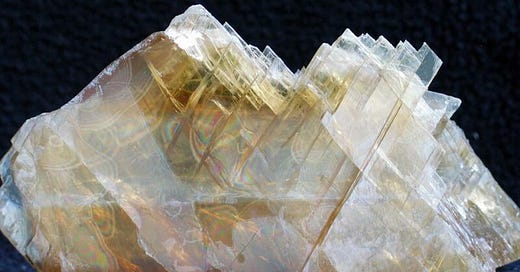Crystal Discovered 900,000 Meters into the Earth
Scientists have recently discovered a new mineral, a new crystal. It has been long hypothesized but until now had never been seen. It was found about 900 kilometres below the surface of the earth.
[Please note that this page contains affiliate links. If you choose to purchase after clicking a link, I may receive a commission at no extra cost to you.]
Scientists have recently discovered a new mineral, a new crystal. It has been long hypothesized but until now had never been seen. It was found about 900 kilometres below the surface of the earth.
The new mineral is called Davemaoite: made of silicon, calcium, and oxygen (calcium silicate, or CaSiO3), it has a similar crystal shape (called a perovskite). It is the first known compound of this kind found in the lower mantle, which is the deepest layer of the earth besides its core.
New Crystal Discovered 900 Km into the Earth
Davemaoite was founded by researchers who collaborated from Florida State University, California Institute of Technology, Nevada Las Vegas, Lawrence Berkeley National Laboratory, and Argonne National Laboratory. They had described their findings in the journal Science.
Researchers found the mineral in a diamond mine dug into the earth's lower mantle using a precise x-ray right down to the micrometre that can send signals through rocks.
After finding the mineral, the researchers described their findings to the International Mineralogical Association and officially acknowledged it as a new mineral.
The discovery gives new evidence of the mineral that's been hypothesized for years that had never been sampled.
The researchers said that this process took over a year as deep earth is not easily accessible.
They used geochemical data and seismic data from rocks that might have been its origin, they could do experiments at the temperatures and pressures of the deep earth, but scientists had no minerals that far into the earth.
Davemaoite: The Newest Mineral
The diamond's inclusion offers the missing information. Although the mineral was discovered trapped in a diamond in Orapa, Botswana, it was added to the Natural History Museum in Los Angeles.
Davemaoite is "unquenchable," which means it can only preserve its structural features under the high-pressure environments of the lower mantle.
The diamond discovered within preserved it from altering the structure in its tour hundreds of kilometres up the earth's outer layers, although scientists believe it will be found in other conditions.
The earth's lower mantle has a pressure 24,000 times that of the earth's atmosphere. Therefore new elements could be found outside of the crust.
This new crystal, for example, would turn into the glass as soon as it entered the atmosphere.
The scientists recreated the temperature-pressure path that the diamond and the crystal took, as they determined that the diamond formed anywhere from 660 and 900 kilometres deep.
Diamond Structure
The diamond that the scientists discovered also brought several trace minerals. This type of structure is called a 'garbage can' by crystal chemists, as it can hold a lot of other minerals.
Researchers believe that Davemaoite makes up about five to seven percent of the earth's lower mantle.
It may seem like not much. Still, it is a critical factor in the overall heat levels of the earth's interior as it decays radioactively (radioactive decay makes up about one-third of the inner earth's heat).
After finding the mineral, the lead scientist would name it after his postdoctoral supervisor, Dave (Ho-Kwang) Mao, a geophysicist.




